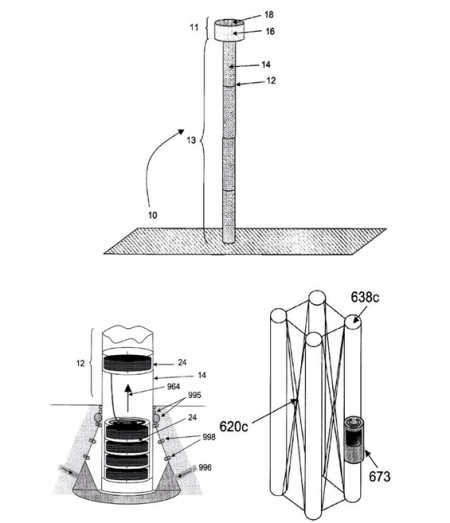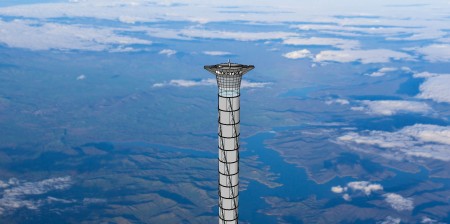August 17, 2015 – A Canadian company applied and was granted a United States design patent for what could prove to be an affordable space elevator. The company is Thoth Technology Inc.
Located near Ottawa, Canada’s capital, Thoth was founded in 2001 and is principally known for design and development of payloads for satellites and robotic systems. The patent for the space elevator is the company’s first foray into large-scale systems.
The elevator would be a freestanding space tower reaching 20 kilometers (12 miles) above the Earth surface. It would measure 230 meters (755 feet) in diameter and would be pneumatically pressurized to maintain structural integrity.
Why 20 kilometers high? Commercial aviation can only get to about 15 kilometers above the Earth surface. And above 19 kilometers atmospheric pressures are so low blood would boil upon exposure to the outside. At 20 kilometers much of the atmosphere and atmospheric drag lies would be below the launch platform, and that would deliver huge cost advantages for getting to near-Earth orbit (NEO). Fuel savings alone would amount to 30%.
But is what Thoth is patenting truly a space elevator? Not quite the same as that foreseen by Konstantin Tsiolkovsky and Arthur C. Clarke who described a space elevator tethered to a satellite in geosynchronous orbit 36,000 kilometers (22,000 miles) above the Earth. Instead Thoth’s invention is more modest, a far less costly compromise that uses known materials and if built could prove advantageous for launching payloads to space. It could be built with multiple decks for rocket launchings delivering satellites to NEO at an estimated $220 per kilogram ($100 per pound). Compare that to today’s costs at $25,000 per kilogram ($11,000 per pound).
Made of inflated core segments forming the inner and outer walls, the tower would feature a hollow middle to provide for the elevator which would not use a cable system. Conventional materials today could not support a 20 kilometer tether. Instead elevator cars would grip and climb the interior walls of the hollowed shaft.
Manufacturing would be a significant challenge. The patent describes the proposed method of construction including extruding core segments from a fluid core material, and embedding the control and stabilization machinery (flywheels) within each segment as extruded. To raise the tower the filing describes a system of rollers and pneumatics.
What would prevent it from collapsing? The flywheels (gyroscopes like those incorporated into rockets and satellites but much larger in scale) which would compensate for all the forces exerted upon it including the Earth’s spin and wind shear.
There is no mention of the cost to build. But there is no doubt that elevators such as this could prove highly advantageous not just as launch platforms, but also as a stationary Earth observation towers capable of providing significant scientific benefits. And because the cost is anticipated to be far less than the Tsiokovsky-Clarke space elevator, Thoth’s design could usher in a new age of space.
The images appearing below are from the 19-page July 21, 2015 filing #9,085,897 B2.










[…] U.S. Patent Issued for Canadian Space Elevator […]